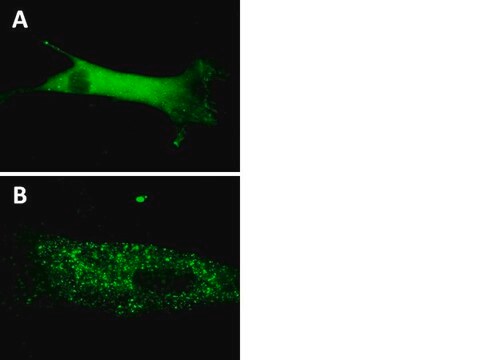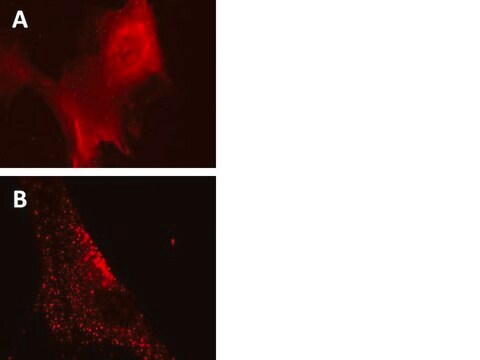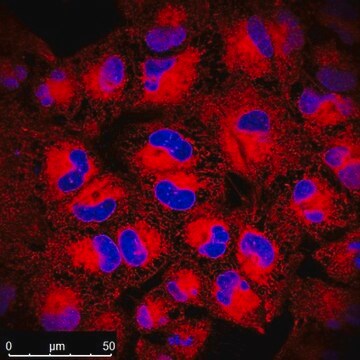17-10143
LentiBrite RFP-LC3 Lentiviral Biosensor
Synonym(s):
Microtubule-associated proteins 1A/1B light chain 3, Autophagy-related protein LC3, Autophagy-related ubiquitin-like modifier LC3, MAP1A/MAP1B light chain 3, Microtubule-associated protein 1 light chain 3
About This Item
Recommended Products
General description
Also available: LentiBrite RFP-p62 Lentiviral Biosensor! Click Here
Read our application note in Nature Methods!
http://www.nature.com/app_notes/nmeth/2012/121007/pdf/an8620.pdf
(Click Here!)
Learn more about the advantages of our LentiBrite Lentiviral Biosensors! Click Here
Biosensors can be used to detect the presence/absence of a particular protein as well as the subcellular location of that protein within the live state of a cell. Fluorescent tags are often desired as a means to visualize the protein of interest within a cell by either fluorescent microscopy or time-lapse video capture. Visualizing live cells without disruption allows researchers to observe cellular conditions in real time.
Lentiviral vector systems are a popular research tool used to introduce gene products into cells. Lentiviral transfection has advantages over non-viral methods such as chemical-based transfection including higher-efficiency transfection of dividing and non-dividing cells, long-term stable expression of the transgene, and low immunogenicity.
EMD Millipore is introducing LentiBrite Lentiviral Biosensors, a new suite of pre-packaged lentiviral particles encoding important and foundational proteins of autophagy, apoptosis, and cell structure for visualization under different cell/disease states in live cell and in vitro analysis.
- Pre-packaged, fluorescently-tagged with GFP & RFP
- Higher efficiency transfection as compared to traditional chemical-based and other non-viral-based transfection methods
- Ability to transfect dividing, non-dividing, and difficult-to-transfect cell types, such as primary cells or stem cells
- Non-disruptive towards cellular function
EMD Millipore’s LentiBrite RFP-LC3 lentiviral particles provide bright fluorescence and precise localization to enable live cell analysis of autophagy in difficult-to-transfect cell types.
EMD Millipore’s LentiBrite RFP-LC3 lentiviral particles provide bright fluorescence and precise localization to enable live cell analysis of autophagy in difficult-to-transfect cell types.
Application
Imaging:
(See Figure 1 in datasheet)
Primary cell type, Human mesenchymal stem cells (HuMSC), were plated in a chamber slide and transduced with lentiviral particles at an MOI of 20 for 24 hours. After media replacement and 48 hours further incubation, cells were either left in complete media or incubated for 4 hours in EBSS containing a lysosome inhibitor, to induce autophagy and inhibit lysosomal degradation of autophagosomes.
Cells were fixed with formaldehyde and mounted. Images were obtained by oil immersion wide-field fluores-cence microscopy. The RFP-LC3 displays a diffuse cytosolic distribution in fed cells, and a punctate distribution in starved autophagic cells.
Immunocytochemistry Comparison and Inhibitor Analysis:
(See Figure 2 in datasheet)
Similar to Figure 1, HeLa cells were plated in a chamber slide and transduced with lentiviral particles at an MOI of 40 for 24 hours. After media replacement and 48 hours further incubation, cells were either left in complete media, incubated for 4 hours in EBSS containing a lysosome inhibitor to induce autophagy and inhibit lysosomal degradation, or incubated as in, with the addition of 5 mM 3-methyladenine (3-MA) as an inhibitor of autophagy. 3-MA completely blocks formation of RFP-LC3-positive autophagic punctae. Immunocytochemical staining (green) of the same fields of view with a monoclonal antibody against LC3A reveals similar expression patterns to the RFP-protein (red).
Hard-to-transfect Cell Type:
(See Figure 3 in datasheet)
Primary cell type HUVEC were plated in a chamber slide and transduced with lentiviral particles at an MOI of 20 for 24 hours. Subsequent treatments for cells left in complete media or cells incubated in EBSS with lysosome inhibitor, were performed as in Figures 1A and 1B.
Confocal Microscopy Imaging:
(See Figure 4 in datasheet)
HeLa cells were treated as in Figures 1A and 1B. Images were obtained by oil immersion confocal fluorescence microscopy.
Additional Cell Type:
(See Figure 5 in datasheet)
HT1080 cells were treated as in Figure 1A and 1B.
For optimal fluorescent visualization, it is recommended to analyze the target expression level within 24-48 hrs after transfection/infection for optimal live cell analysis, as fluorescent intensity may dim over time, especially in difficult-to-transfect cell lines. Infected cells may be frozen down after successful transfection/infection and thawed in culture to retain positive fluorescent expression beyond 24-48 hrs. Length and intensity of fluorescent expression varies between cell lines. Higher MOIs may be required for difficult-to-transfect cell lines.
Components
One vial containing 25 µL of lentiviral particles at a minimum of 3 x 10E8 infectious units (IFU) per mL.
For lot-specific titer information, please see “Viral Titer” in the product box above.
Promoter
EF-1 (Elongation Factor-1)
Multiplicty of Infection (MOI)
MOI = Ratio of # of infectious lentiviral particles (IFU) to # of cells being infected.
Typical MOI values for high transduction efficiency and signal intensity are in the range of 20-40. For this target, some cell types may require lower MOIs (e.g., HT-1080, HeLa), while others may require higher MOIs (e.g., human umbilical vein endothelial cells (HUVEC), U2OS, human mesenchymal stem cells (HuMSC)).
NOTE: MOI should be titrated and optimized by the end user for each cell type and lentiviral target to achieve desired transduction efficiency and signal intensity.
Quality
Legal Information
Storage Class
10 - Combustible liquids
wgk_germany
WGK 2
Certificates of Analysis (COA)
Search for Certificates of Analysis (COA) by entering the products Lot/Batch Number. Lot and Batch Numbers can be found on a product’s label following the words ‘Lot’ or ‘Batch’.
Already Own This Product?
Find documentation for the products that you have recently purchased in the Document Library.
Articles
High titer lentiviral particles for LC3 variants used for live cell analysis of cellular autophagy.
Related Content
Fluorescent lentiviral particles encoding important GFP/RFP fusion proteins related to autophagy, apoptosis, and cell structure that enables live cell imaging.
Our team of scientists has experience in all areas of research including Life Science, Material Science, Chemical Synthesis, Chromatography, Analytical and many others.
Contact Technical Service








